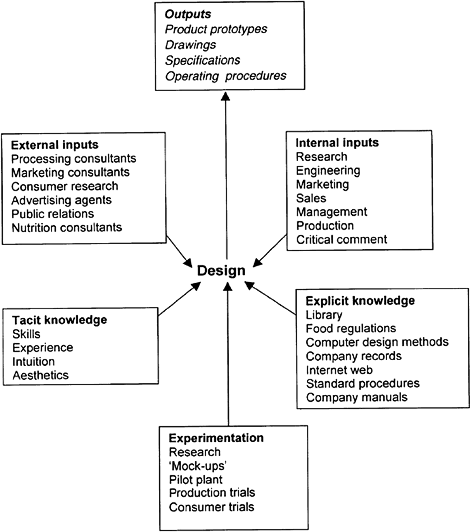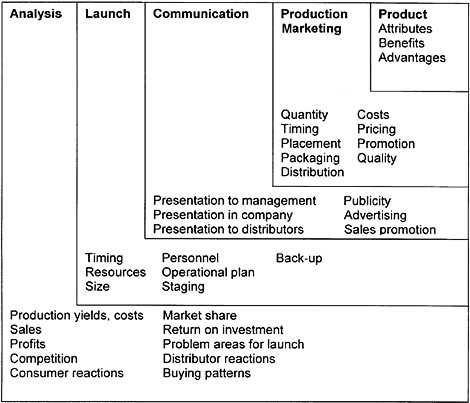FOOD
PRODUCT DEVELOPMENT
Mary Earle, Richard Earle and Allan Anderson |
| Loading
|
|
||||
|
|
Part
I,
Chapter 1
Keys to new product success and failure 1.4.1 Stages in the PD Process PD Processes vary according to the level of product innovation, the company's knowledge and resources, the time constraints and the level of risk taking in the company; but there are basic, necessary activities in every stage of the process.
Stage 1: Product strategy development This has received a great deal of attention in recent years - as one might say taking the 'fuzziness' out of it has been the aim. There is a need for a clear focus; a business definition and a product definition have to be developed in the early stages (Kmetovicz, 1992). The activities of product, market and technology research in this stage are often recognised as vital for successful product development. The product concept and if possible the product design specifications plus a report on the feasibility of the project are the outcomes of this stage. Many times it has been stressed that there should be early definition of what the new product should offer the consumer/customer, that is the benefits, desired product characteristics, uses, safety, value. With the consumers/customers, a product concept is developed describing the product as the consumer sees it and wants it. This product concept is developed into more quantitative descriptions by relating the product concept to both the product metrics, which can be measured by physical, chemical, microbiological or sensory tests, and also the processing, production and marketing methods. The resulting product design specifications give clear directions to the designer. There is an interaction often between the building of the product concept and the product design specification and the initial design of the product. Stage 2: Product design and process development This stage is important because a unique product is a key element in product development success. It all depends how one defines uniqueness, but it is mostly a noticeable change that is being achieved rather than a completely new product, as illustrated by Griffin's (1997) comments from the Product Development and Management Association (PDMA) survey in Box 1.1.
In the food industry, where thousands of new products are placed on the shelves in a year, the newness can be quite minor such as a different flavour, a package face change, a different slice thickness. It may be opportune to look at the degrees of product difference being achieved in food design and to decide if the expensive launches are worthwhile for such minor product changes. It has been noted many times that a unique, superior product is a key issue, but seldom have the methods to achieve it been identified. Industrial design in general is moving away from the traditional belief that it is the creative workings of one person, to the concept of a design team. Industrial designers are also moving into the area of food design, bringing their more aesthetic attitudes in design. The food designers (often called food developers) are much further ahead than other designers in bringing consumers, or at least consumer needs, into the design process. Also because of the close connection between the process and the product qualities, they have often a closer interrelationship between product design and process development, using computer-based experimental designs and analysis. For successful product design there need to be multidisciplinary skills closely integrated, consumer involvement and creativity, combined with the functional areas of marketing and production. In the food industry, the term product design is seldom used, it is more commonly called food product development. Increasingly, there is a need to recognise the principles of design, as the industrial designers become more involved in food design. 'Design and food have decidedly embarked on a union that will forever change the course of both' (Pearlman, 1998). As an example 'Snackitecture', with shapes and colours such as Trix wildberry corn puffs, Heinz Barbie Pasta Shapes in tomato sauce, or pizza-flavoured goldfish, is recognised in design journals (Kalman, 1998). Product design is the central, creative part of product development and it is important that the different factors influencing it are recognised and integrated into the design process as shown in Fig. 1.6. Product design is based on the tacit knowledge of the designers but it has input from many disciplines and functional areas. It is a blend of creativity, research and testing.  Fig. 1.6 Design components in food product development. Stage 3: Product commercialisation This has two activities identified as related to product development success - business analysis and marketing the product to the people in the functional areas (Cooper, 1993; Crawford, 1997), but there are many other aspects of product commercialisation that lead to product success. Business analysis is essential for the decision making at this stage but amazingly there are still companies who never do this before spending large amounts of money in commercialisation and launching. Communication between the design team and the functional groups that will carry the product into production and marketing is essential - this is often called technology transfer, but is better called technology cooperation or technology integration. There are two important facts to recognise in commercialisation - firstly it is still a design process and secondly integration of the functional areas is vital. The key issues are:  maintain the product
qualities at the same standard as in the design maintain the product
qualities at the same standard as in the designthrough the process and the distribution;  produce and distribute at the quantities needed; produce and distribute at the quantities needed; develop
a total product concept for marketing that agrees with the develop
a total product concept for marketing that agrees with theconsumer needs and wants and creates unique value for the chosen target market;  organise a distribution channel which ensures quality, quantity and costs; organise a distribution channel which ensures quality, quantity and costs; reduce uncertainty and risk in the launching; reduce uncertainty and risk in the launching; reach the predicted sales and profits. reach the predicted sales and profits.In product commercialisation, the product prototype and the preliminary product specifications and marketing strategy have to be developed into a commercial product and production and marketing plans.
Stage 4: Product launch and evaluation This is the most expensive and risky part of product development. The key issue is to have a fast and effective launch as this can generate the same or more incremental profits as reducing the time for the early stages of the PD process (Ottum, 1996; Stryker, 1996). The targets for the launch should be clearly set to provide the basis for the evaluation. It is important for the company to decide on the measures for the launch so that success and failure are clearly defined and measured. The goals might be selected revenues over time, or the market share over time, or profits over time, or for the product to be long term in the product mix. The environment is also important; competition and possibly social, political or economic changes should be monitored. The operational plan for the launch is a key for success but it needs to be sensitive to the situational and operational conditions. Another key factor is the launching to the company and to the trade (distributors). People can easily slow or divert a launch and on the other hand can quickly and successfully overcome any problems that may arise. In industrial product development, it is important to have different departments in the buying company knowledgeable and enthusiastic for the product, and in consumer product development, the retailer as well as the consumer must not be fearful or bored about the product, but encouraged to buy it. Evaluation is continuous so that improvements can be made quickly. The key factors for the launch are shown in Fig. 1.7.  Fig. 1.7 Key factors for launch.
|
||||||||||||||||||||||||||||||||
|
 |